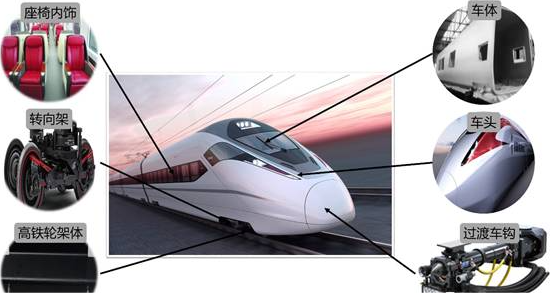With the rapid development of modern rail transportation technology, lightweight, high efficiency and environmental protection and energy saving have become the core keywords for the development of the industry. In this context, the development and application of composite body design platform is particularly important. In this paper, the importance and practical value of composite body design platform for rail transportation will be discussed from the aspects of performance advantages of composite materials, construction of design platform, specific application cases, and challenges and future prospects.
一.Performance Advantages of Composite Materials
Composite materials, especially carbon fiber composites (CFRP) and glass fiber composites (GFRP), show great application potential in the field of rail transportation due to their unique physical and chemical properties.
First of all, composite materials are characterized by light weight and high strength. Carbon fiber, for example, its density is only 57% of aluminum, but the strength is 3.6 times that of aluminum, which means that while ensuring the structural strength, it can significantly reduce the weight of the vehicle, thereby enhancing the vehicle’s transport efficiency and energy utilization. Secondly, the composite material has excellent fatigue and corrosion resistance. Their laminated structure effectively resists crack expansion, extending vehicle service life and reducing maintenance costs. In addition, composite materials also have high damping characteristics, can effectively absorb and disperse vibration energy, reduce noise and vibration during train operation, and enhance ride comfort.

二.the construction of the design platform
In order to give full play to the advantages of composite materials, there is an urgent need to build a set of efficient and accurate composite body design platform in the field of rail transportation. This platform should cover the whole process from conceptual design, detailed design to manufacturing, and realize the integration of design simulation and manufacturing. For example, Dassault Systèmes’ MBSE (Model based Systems Engineering) solution provides strong support for composite body design. Through the MBSE methodology, designers can quickly validate conceptual solutions and utilize simulation technology to model the performance of different design options in order to select the optimal solution.
At the same time, the platform also has comprehensive layup design and review functions, as well as the integration capability of design simulation to ensure the accurate transmission and efficient utilization of design data.
三.specific application cases
Globally, the application of composite body design platform has achieved remarkable results. In Japan, for example, the Shinkansen N700 high-speed train adopts carbon fiber composite body skin and insulators and other components, which significantly reduces the weight of the body and improves the operation efficiency. In China, Sifang Company of China Railway has applied carbon fiber composite hood in Guangzhou Metro Line 18 project, realizing further reduction in the quality of the whole vehicle, and at the same time improving the energy-saving and environmental protection performance of the train as well as the ride comfort.
四.Challenges and future prospects
Although the composite body design platform shows great potential for application in the field of rail transportation, its promotion and application still face some challenges. First, the production cost of composite materials is relatively high, which limits their application in mass production. Secondly, the processing and manufacturing technology of composites is relatively complex and requires high process control. In response to these challenges, future efforts need to be made in the following areas.










